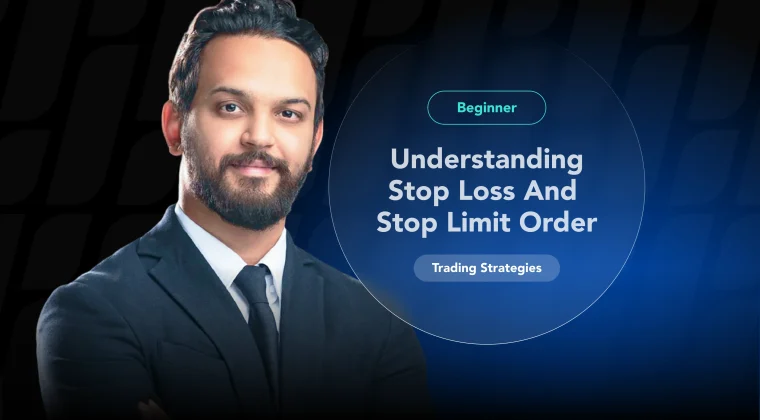-
- Trading Platforms
- PU Prime App
- MetaTrader 5
- MetaTrader 4
- PU Copy Trading
- Web Trader
- PU Social
-
- Trading Conditions
- Account Types
- Spreads, Costs & Swaps
- Deposits & Withdrawals
- Fee & Charges
- Trading Hours

Stop loss orders and stop limit orders are often used in trading CFD, which stands for Contract For Differences, to limit losses on a position. A stop loss order is an order to sell a security when it reaches a certain price, while a stop limit order is an order to sell a security at a specified price or better. Both types of orders can help traders to manage risk by automatically closing a position when the price of the security reaches a certain level. This can be particularly useful in CFD trading, where leveraged positions can amplify losses. Read on to understand more about these strategies.
Stop loss order and stop limit order are commonly used by CFD traders in risk management.
A stop loss order is a type of order that is placed with a broker to automatically close a trade at a certain price level, in order to limit an investor’s potential losses. When trading Contracts for Difference (CFDs), placing a stop loss order can be an effective risk management tool.
When you place a stop loss order, you specify the maximum amount of money that you are willing to lose on a trade. If the market price moves against you and reaches the stop loss level you have set, your trade will be closed automatically at the stop loss price to limit your loss. This means that if you open a short CFD position, your trade will be closed if the market price rises to your stop loss level and if you open a long position, your trade will be closed if the market price falls to your stop loss level.
Using stop loss orders can be a helpful risk management technique in CFD trading as it helps you to have better control over the potential losses, but it’s important to keep in mind that while stop loss orders can help limit your losses, they cannot guarantee that you will not lose money on a trade.
There are two common schools of thought when choosing a stop loss level. The first and easier one is to decide on the loss percentage that you are willing to take on a trade. For example, placing a stop loss that is 10% below the market price on a long position means that you are limiting the losses on this trade to 10% of the trade’s value.
The second method is more complicated, involving using technical analysis to determine support and resistance levels that will be used to determine stop-loss levels. A long position will use a recent support level as a stop-loss; while a short position will use a recent resistance level as a stop-loss. This stems from the belief that a breakout from a resistance or support level usually indicates a further move up or down.
When trading Contracts for Difference (CFDs), placing a stop-limit order can be an effective way to limit potential losses or protect profits.
When you place a stop-limit order in CFD trading, you specify two prices: the stop price and the limit price. The stop price is the level at which your order will be triggered, and the limit price is the price at which your order will be executed.
For example, let’s say you have a long position in a stock CFD at $100 and you want to protect your profits. You could place a stop-limit sell order with a stop price of $10 above your entry price and a limit price of $5 above your entry price. This means that if the market price of the stock rises to $110, your order will be triggered and become a limit order to sell at $105 or above.
In this scenario, if the stock price gaps down below $105, your order will not be executed at all. In this way, you are limiting your potential profit, but protecting your gains from a falling market.
On the other hand, if you are holding a short position in the same stock and trying to limit losses in a rising market, you can place a stop-limit order with a price $110, with a limit price of $115. This means that if the market price of the stock increases to $110, your order will be triggered, and if an order can be filled at below $115, it will be executed – limiting any potential losses beyond $15 on your short position.
It’s important to keep in mind that like stop loss orders, stop-limit orders do not guarantee that the order will be filled and it will only be executed if there is a willing buyer or seller at the limit price or better.
However, in times of outsized movements, a limit order will prevent positive slippage at the risk of not having your order executed; while a stop order will run the risk of slippage as the price gaps up or down.

Placing stop loss and stop limit orders in Contracts for Difference (CFD) trading typically involves the following steps:
1. Open a trading account
2. Research the market: Before placing an order, it is important to research the market and the assets that you plan to trade. This will help you to understand the current market conditions and make informed decisions about your trade.
3. Decide on a trading strategy: your overall trading plan will decide on the kind of losses or profits you are willing to take, and the subsequent stop-loss and stop limit levels you want to set.
4. Enter the order details: Once you have selected the order type, you will need to enter the order details, such as the stop price and the limit price for a stop limit order or the stop loss price for a stop loss order.
5. Place the order: Once you have entered the order details, you can place the order. The order will be triggered and/or executed at the specified price levels.
It’s worth noting that different platforms, brokers, and providers might have different ways of presenting the order types and settings, but in general the mechanisms should be similar.
It is important to keep in mind that stop loss and stop limit orders are risk management tools and don’t guarantee a profit or prevent all losses, they help to manage the risk and should be part of a comprehensive trading strategy.
Step into the world of trading with confidence today. Open a free PU Prime live CFD trading account now to experience real-time market action, or refine your strategies risk-free with our demo account.
This content is for educational and informational purposes only and should not be considered investment advice, a personal recommendation, or an offer to buy or sell any financial instruments.
This material has been prepared without considering any individual investment objectives, financial situations. Any references to past performance of a financial instrument, index, or investment product are not indicative of future results.
PU Prime makes no representation as to the accuracy or completeness of this content and accepts no liability for any loss or damage arising from reliance on the information provided. Trading involves risk, and you should carefully consider your investment objectives and risk tolerance before making any trading decisions. Never invest more than you can afford to lose.

Trade forex, indices, metal, and more at industry-low spreads and lightning-fast execution.
Sign up for a PU Prime Live Account with our hassle-free process.
Effortlessly fund your account with a wide range of channels and accepted currencies.
Access hundreds of instruments under market-leading trading conditions.

Please note the Website is intended for individuals residing in jurisdictions where accessing the Website is permitted by law.
Please note that PU Prime and its affiliated entities are neither established nor operating in your home jurisdiction.
By clicking the "Acknowledge" button, you confirm that you are entering this website solely based on your initiative and not as a result of any specific marketing outreach. You wish to obtain information from this website which is provided on reverse solicitation in accordance with the laws of your home jurisdiction.
Thank You for Your Acknowledgement!
Ten en cuenta que el sitio web está destinado a personas que residen en jurisdicciones donde el acceso al sitio web está permitido por la ley.
Ten en cuenta que PU Prime y sus entidades afiliadas no están establecidas ni operan en tu jurisdicción de origen.
Al hacer clic en el botón "Aceptar", confirmas que estás ingresando a este sitio web por tu propia iniciativa y no como resultado de ningún esfuerzo de marketing específico. Deseas obtener información de este sitio web que se proporciona mediante solicitud inversa de acuerdo con las leyes de tu jurisdicción de origen.
Thank You for Your Acknowledgement!